|
BumblebeeID
- find British species by colour pattern
The colour
pattern of this species is variable. Lighter forms occur
on the mainland and are especially pale (above left)
in the south. Darker forms (with black on the underside
and legs) occur on the Inner and Outer Scottish Isles
and on Shetland (the most extreme dark forms, above
right, occur on the Irish Aran Islands of Galway Bay).
The dark forms have long been known by the name 'smithianus'
(a misidentification).
A range of intermediate colour forms with both yellow
and black hair on the face and on the underside occur
on the Isle of Skye in western Scotland. Colour forms
from the Scilly Isles and Orkneys may also be considered
intermediate.
Distinguishing
similar species:
Unlike B.
pascuorum and B.
humilis, B. muscorum (1) is large with
short even hair, (2) has no black hairs above the wing
bases, (3) the hair at the front of abdominal segment
2 is scarcely darker than on segment 4, (4) the hair
on abdominal segment 1 is scarcely lighter than that
on the sides of segment 3;
and males can be distinguished by their
genitalia.
'Large
Carder-bee'
(Sladen,
1912)
'Moss Carder-bee'
(Step, 1932)
'Moss
carder bee'
(BBCT)
taxonomy and nomenclature
|
A large
species with a mid-length tongue, emerging in late spring,
and nesting on the surface of the ground. In its nest structure,
Sladen (1912) describes
it as a 'pocket-making' 'carder bee'. Colonies can be aggressive
when disturbed.
|
| Habitat |
In
the south, mainly on coastal marshes, and in the north, on
bogs and heaths. Possibly also formerly in flower-rich low-intensity
water meadows in central England. Common on many northern
islands. Said to prefer damp cold seasons (Sladen, 1912)
and to prefer wetter habitats than the similarly-coloured
B. humilis (although
the two co-occur at many southern coastal sites). It is also
less likey to co-occur with B. jonellus,
which prefers drier habitats, at least in the south.
|
|
British
distribution
Species
Recovery Programme
|
Throughout
Britain, more frequent in the north and has become
rarer in the central and southern lowlands (see
declines).
Recently, it has become rarer in the north (Plowright
et al., 1997).
Data from Alford (1980)
are mapped on a 10 km grid (left) to show local
patchiness and on a 50 km grid (right) to show changes
in the regional pattern (dark blue - post 1960;
light blue - pre 1960 only):
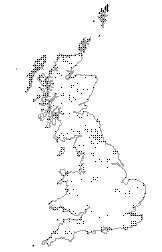 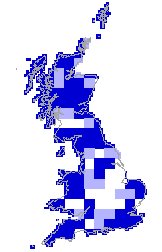
|
| Worldwide
distribution |
Europe
and northern Asia to the Pacific. World distribution mapped
on an equal-area grid (dark
blue - specimens identified by PHW; light blue - literature
records; white - expected distribution):
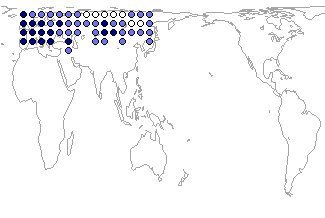
|
|
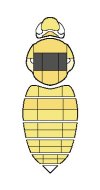
queen/worker
|
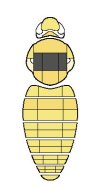
male |
|
|
|
Distinguishing
similar species:
B.
distinguendus queens and workers are unmistakable
in Britain with their large size, extensively yellow
hair, and black band between the wing bases; males can
be distinguished from B.
campestris and B.
subterraneus by their
genitalia.
'Great
Yellow Humble-bee'
(Sladen,
1912; Step, 1932)
'Great
yellow bumblebee'
(BBCT)
taxonomy and
nomenclature
|
A large
species, with a long tongue, emerging in late spring, and
nesting below the surface of the ground or on the surface.
In its nest structure, Sladen (1912)
describes it as a 'pocket-making' 'pollen-primer' species.
Colonies are small.
|
| Habitat |
Flower-rich
tall grassland, heathland, bogs, and marshes. Probably also
formerly in flower-rich low-intensity farmland. One of its
principal remaining strongholds is the Scottish tall machair
(Edwards, 2000).
|
|
British
distribution
Biodiversity
Action Plan priority species
|
Formerly
widely scattered throughout Britain, now frequent
only in parts of the north of Scotland, absent from
the Scilly Isles and Shetland, and has become rarer
in the central and southern lowlands (see declines).
Data from Alford (1980)
are mapped on a 10 km grid (left) to show local
patchiness and on a 50 km grid (right) to show changes
in the regional pattern (dark blue - post 1960;
light blue - pre 1960 only):
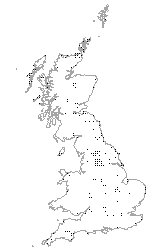 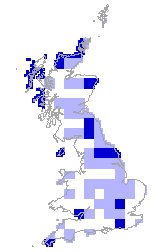
|
| Worldwide
distribution |
Europe
and northern Asia to the Pacific. World distribution mapped
on an equal-area grid (dark
blue - specimens identified by PHW; light blue - literature
records; white - expected distribution):
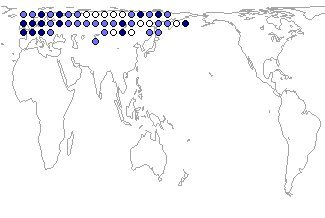
|

worker |
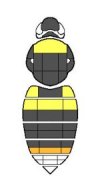
worker |
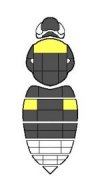
queen/worker |
|
|
|
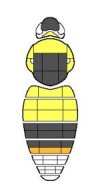
male
|
|
|
|
|
Distinguishing
similar species:
Unlike
B. lucorum
and B.
terrestris, B. soroeensis queens and
workers (1) usually have the first segment of the abdomen
with yellow hair at the sides, (2) the second segment
is often narrowly black in the middle, (3) the hind
basitarsus has only a weakly arched hind margin; and
for males (1) the antennae are long and (2) the base
of the hind basitarsus is narrow and broadens gradually
without a shoulder (see Prys-Jones & Corbet, 1987,
1991).
Against other species, males can be distinguished by
their
genitalia.
'Ilfracombe
Humble-bee'
(Sladen,
1912)
'Broken-belted Humble-bee'
(Step, 1932)
'Broken-belted
bumblebee'
(BBCT)
taxonomy and
nomenclature
|
A small
species, with a short tongue, emerging in late spring, and
nesting below the surface of the ground. In its nest structure,
Sladen (1912), who had
not seen a nest, and Løken (1973)
placed it with the 'pollen-storer' species (requiring confirmation).
Colonies are small.
|
| Habitat |
Flower-rich
tall grassland, heathland, uplands, woodland glades and edges.
Probably also formerly in flower-rich low-intensity farmland.
|
|
British
distribution
Species
Recovery Programme
|
Throughout
Britain, more frequent in the north and west, absent
from the Outer Scottish Isles and Scilly Isles and
has apparently become rarer in the central and southern
lowlands (see declines).
Abundance has been fluctuating in Scotland (Macdonald,
2000, 2001)
and it has recently been recorded from many more
localities in southern England (Else, 2000;
Williams, 2005).
Data from Alford (1980)
are mapped on a 10 km grid (left) to show local
patchiness and on a 50 km grid (right) to show changes
in the regional pattern (dark blue - post 1960;
light blue - pre 1960 only):
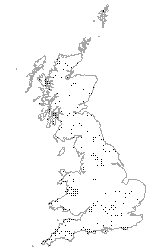 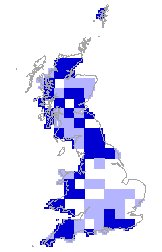
|
| Worldwide
distribution |
Europe
east to the Tien Shan and Mongolia. World distribution
mapped on an equal-area
grid (dark
blue - specimens identified by PHW; light blue -
literature records; white - expected distribution):
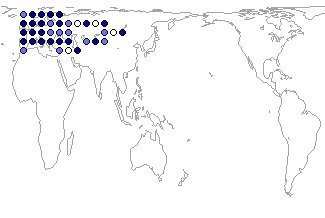
|
The orange-tailed
colour form is restricted to the Outer Scottish Isles
and is usually most pronounced in the males. Specimens
with more yellowish tails are known from the Isle of
Man and Shetland. The yellow bands are sometimes narrowed,
or more rarely completely absent.
Distinguishing
similar species:
Unlike B. hortorum
and B. ruderatus, B.
jonellus (1) have the head round and about as long as broad,
and (2) queens and workers have no spine on the mid basitarsus
(see Prys-Jones & Corbet, 1987,
1991).
Unlike B. pratorum,
orange-tailed B. jonellus queens and workers have a pale
band at the rear of the thorax; and the males can be distinguished
by their
genitalia.
'Heath
Humble-bee'
(Sladen,
1912; Step, 1932)
'Heath
bumblebee'
(BBCT)
taxonomy and nomenclature
|
A small
species, with a short tongue, emerging in early spring (or
relatively later in the Outer Scottish Isles, D. Goulson
in litt., 2005), and nesting below the surface of
the ground, though sometimes on the surface, or above the
surface in cavities. This species nests particularly early
in the year. It is less often seen in late summer and these
records may often be for bees reared in secondary nests
by queens produced earlier in the same year. In its nest
structure, Sladen (1912)
describes it as a 'pollen-storer' species. Colonies are
small.
|
| Habitat |
Heathland,
grassland, uplands, less common on farmland and woodland glades
and edges. It is less likey to co-occur with B.
muscorum, which prefers wetter habitats, at least
in the south.
|
|
British
distribution
|
Throughout
Britain, more frequent in the north and west and
has become rarer in some of the central and southern
lowlands (see declines).
Recently recorded from many more localities in the
southern lowlands. Data from Alford (1980)
are mapped on a 10 km grid (left) to show local
patchiness and on a 50 km grid (right) to show changes
in the regional pattern (dark blue - post 1960;
light blue - pre 1960 only):
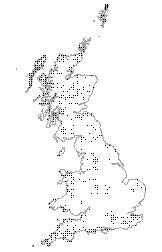 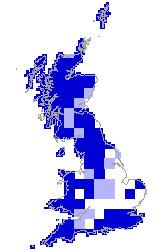
|
| Worldwide
distribution |
Europe,
northern Asia, Alaska, and Canada east to Hudson Bay. World
distribution mapped on an equal-area
grid (dark
blue - specimens identified by PHW; light blue - literature
records; white - expected distribution):
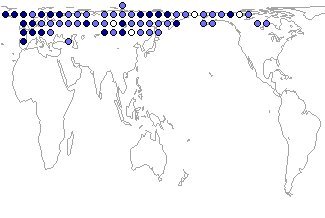
|
Distinguishing
similar species:
B. monticola
are unmistakable in Britain with their extensively red hair and
bright yellow bands on the thorax; males can be distinguished
by their
genitalia.
'Mountain
Humble-bee'
(Sladen,
1912)
'Bilberry Humble-bee'
(Step, 1932)
'Bilberry
bumblebee'
(BBCT)
taxonomy and nomenclature
|
A medium-sized
species, with a short tongue, emerging in early spring,
and nesting below the surface of the ground or on the surface.
In its nest structure, Sladen (1912)
places it in his group of 'pollen-storer' species. Colonies
are small.
|
| Habitat |
Uplands.
It has been described as associated particularly with Bilberry
(Vaccinium myrtillus L.) habitats (e.g. Step, 1932;
Alford, 1980; Yalden, 1983;
Edwards, 2002), but is
more closely associated with uplands at altitudes above 300
m (which also tend to have Bilberry) than with the broader
distribution of Bilberry alone (Williams, 1988).
|
|
British
distribution
Species
Recovery Programme
|
North
and west of Britain in the uplands, absent from the Scilly
Isles, Orkneys, Shetland, the Outer and most Inner Scottish
Isles. Data from Alford (1980)
are mapped on a 10 km grid (left) to show local patchiness
and on a 50 km grid (right) to show changes in the regional
pattern (dark blue - post 1960; light blue - pre 1960 only):
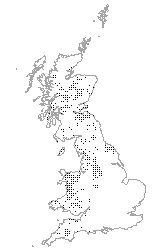 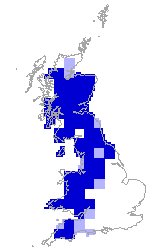
|
| Worldwide
distribution |
Mountains
and uplands of Europe. World distribution mapped on an equal-area
grid (dark
blue - specimens identified by PHW; light blue - literature
records; white - expected distribution):
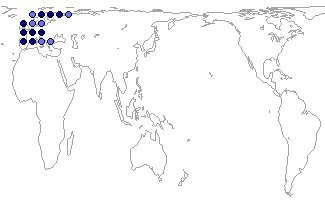
|
alphabetic
British list | distribution
of British species | colour
patterns | colour
diagrams
 top of page
top of page
|